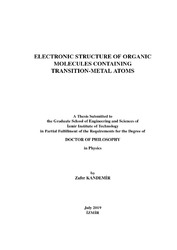Please use this identifier to cite or link to this item:
https://hdl.handle.net/11147/7496Full metadata record
| DC Field | Value | Language |
|---|---|---|
| dc.contributor.advisor | Bulut, Nejat | |
| dc.contributor.author | Kandemir, Zafer | - |
| dc.date.accessioned | 2019-12-17T13:20:33Z | |
| dc.date.available | 2019-12-17T13:20:33Z | |
| dc.date.issued | 2019-07 | en_US |
| dc.identifier.citation | Kandemir, Z. (2019). Electronic struture of organic molecules containing transition-metal atoms. Unpublished doctoral dissertation, Izmir Institute of Technology, Izmir, Turkey | en_US |
| dc.identifier.uri | https://hdl.handle.net/11147/7496 | |
| dc.description | Thesis (Doctoral)--Izmir Institute of Technology, Physics, Izmir, 2019 | en_US |
| dc.description | Includes bibliographical references (leaves: 184-191) | en_US |
| dc.description | Text in English; Abstract: Turkish and English | en_US |
| dc.description.abstract | Hemoglobin including iron atom, vitamin B12 containing cobalt atom and ruthenium- based dye molecules are examples of organic molecules. We explore whether electron correlations arising from transition-metal atoms have any special role in the functioning of organic molecules using the effective multi-orbital Anderson model. We choose deoxy and oxy-heme molecules which are examples of hemoglobin derivatives because they have many experimental and theoretical studies. The experimental magnetic susceptibility measurements find that deoxy and oxy-heme molecules exhibit a high-spin to low-spin transition. We use four different computational methods: density functional theory (DFT), DFT+U, DFT+mean-field approximation (DFT+MFA) and DFT+quantum Monte Carlo (DFT+QMC) to study this transition. In this thesis, we compare the results of these methods with each other and the experimental results. DFT and DFT+U methods do not yield the high-spin state for deoxy-heme. DFT method correctly does not find the location of impurity bound state (IBS) known as correlated new electronic states. These methods obtain low-spin for oxy-heme, but they find that magnetic correlations are very small. DFT+MFA works well for high-spin, but this technique does not obtain low-spin because it does not find the location of IBS correctly. DFT+QMC gives the high(low)- spin state for deoxy-heme (oxy-heme) and finds IBS and magnetic correlations. We obtain that DFT+QMC works better among these methods for deoxy and oxy-heme molecules. Moreover, we investigate whether we can observe the IBS and magnetic correlations for vitamin B12, dye molecules and single-atom catalysts by using these computational approaches. | en_US |
| dc.description.abstract | Demir atomu içeren hemoglobin, kobalt atomu içeren vitamin B12 ve rutenyumbazlı boya molekülleri organik moleküllere örnektir. Geçiş-metali atomlarından kaynaklanan elektron korelasyonlarının, etkin çok-orbitalli Anderson modelini kullanarak organik moleküllerin işleyişinde özel bir rolü olup olmadığını araştırıyoruz. Hemoglobin türevlerinin örnekleri olan deoksi ve oksi-hem moleküllerini, birçok deneysel ve teorik çalışmaları olduğu için seçtik. Deneysel manyetik duyarlılık ölçümleri, deoksi ve oksihem molekülleri yüksek-spinden düşük-spine geçiş sergilediğini tespit eder. Bu geçişi çalışmak için dört farklı hesapsal metot kullandık: yoğunluk fonksiyonel teorisi (YFT), YFT+U, YFT+ortalama-alan yaklaşımı (YFT+OAY) ve YFT+kuantum Monte Carlo (YFT+KMC). Bu tezde, bu yöntemlerin sonuçlarını birbirleri ile ve deneysel sonuçlarla karşılaşstırıyoruz. YFT ve YFT+U metotları deoksi için yüksek-spin durumunu vermiyor. YFT metodu, korelasyonlu yeni elektronik durum olarak bilinen safsızlık bağıl durumunun (SBD) yerini doğru şekilde bulamaz. Bu metotlar oksi-hem için düşük-spini elde eder, fakat manyetik korelasyonların çok küçük olduğunu bulurlar. YFT+OAY, yüksek-spin için çok iyi çalışır, ancak SBD’nin yerini doğru şekilde bulamadığı için düşük-spin durumunu elde edemez. YFT+KMC, deoksi-hem (oksi-hem) için yüksek(düşük)-spin durumunu verir, ve SBD ve manyetik korelasyonları bulur. YFT+KMC’nin deoksi ve oksihem molekülleri için bu yöntemler arasında daha iyi çalıştığını elde ettik. Ayrıca, bu hesapsal yaklaşımları kullanarak vitamin B12, boya molekülleri ve tek-atom katalizörleri için SBD ve manyetik korelasyonları gözlemleyip gözlemleyemeyeceğimizi araştırıyoruz. | en_US |
| dc.description.sponsorship | TUBITAK (110T387 and 113F242) and TUBITAK ULAKBIM | en_US |
| dc.format.extent | xxxvii, 217 leaves | en_US |
| dc.language.iso | en | en_US |
| dc.publisher | Izmir Institute of Technology | en_US |
| dc.rights | info:eu-repo/semantics/openAccess | en_US |
| dc.subject | Organic molecules | en_US |
| dc.subject | Hemoglobin | en_US |
| dc.subject | Density Functional Theory | en_US |
| dc.subject | Bioinorganic molecules | en_US |
| dc.subject | Anderson model | en_US |
| dc.subject | Electronic structure | en_US |
| dc.title | Electronic struture of organic molecules containing transition-metal atoms | en_US |
| dc.title.alternative | Geçiş elementi içeren organik moleküllerin elektronik yapısı | en_US |
| dc.type | Doctoral Thesis | en_US |
| dc.institutionauthor | Kandemir, Zafer | - |
| dc.department | Thesis (Doctoral)--İzmir Institute of Technology, Physics | en_US |
| dc.relation.tubitak | info:eu-repo/grantAgreement/TUBITAK/MFAG/113F242 | |
| dc.relation.tubitak | info:eu-repo/grantAgreement/TUBITAK/TBAG/110T387 | |
| dc.relation.publicationcategory | Tez | en_US |
| item.languageiso639-1 | en | - |
| item.openairecristype | http://purl.org/coar/resource_type/c_18cf | - |
| item.openairetype | Doctoral Thesis | - |
| item.cerifentitytype | Publications | - |
| item.fulltext | With Fulltext | - |
| item.grantfulltext | open | - |
| crisitem.author.dept | 01. Izmir Institute of Technology | - |
| Appears in Collections: | Phd Degree / Doktora | |
Files in This Item:
| File | Description | Size | Format | |
|---|---|---|---|---|
| T002057.pdf | DoctoralThesis | 15.39 MB | Adobe PDF |  View/Open |
CORE Recommender
Page view(s)
214
checked on Oct 14, 2024
Download(s)
98
checked on Oct 14, 2024
Google ScholarTM
Check
Items in GCRIS Repository are protected by copyright, with all rights reserved, unless otherwise indicated.